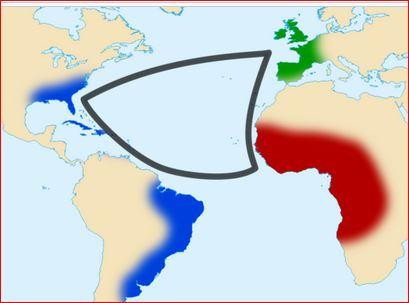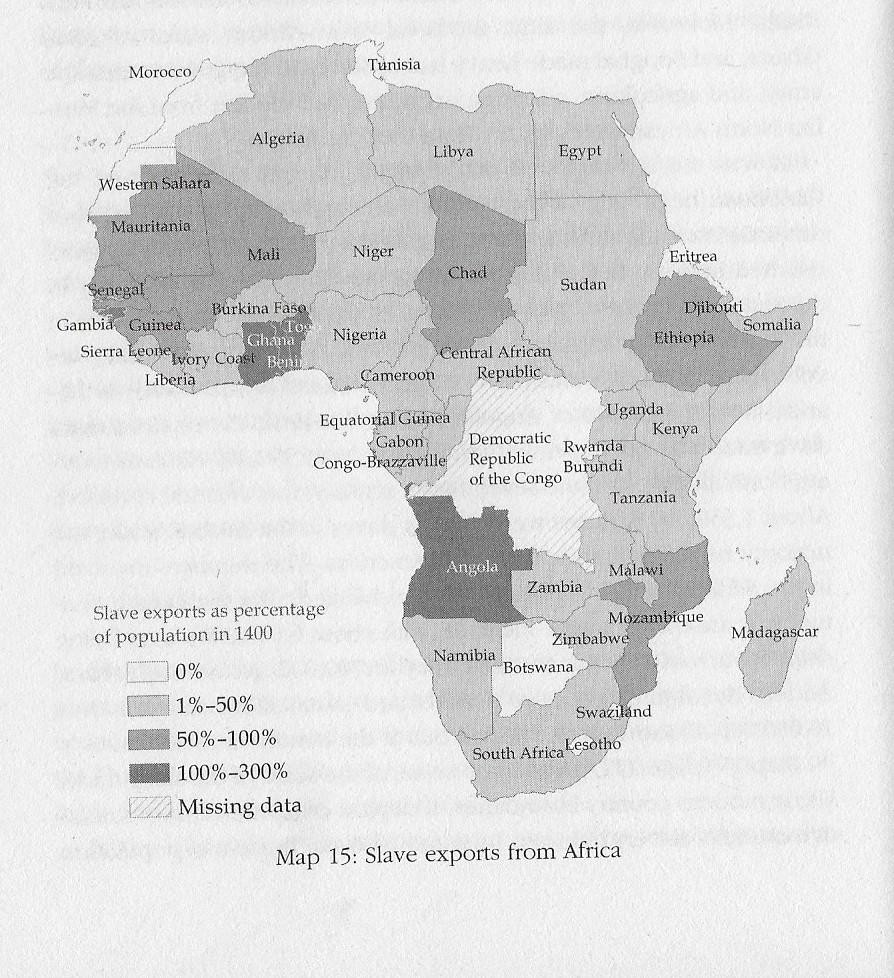This is an extract from the book of Daron Acemoglu and James A Robinson "Why nations fail: the origins of power, prosperity and poverty" pages 250-258
Historically, as the great classical scholar Moses Finley pointed out, slavery was anything but peculiar, it was present in almost every society. It was, as we saw earlier, endemic in Ancient Rome and in Africa, long a source of slaves for Europe, though not the only one.
In the Roman period slaves came from Slavic peoples around the Black Sea, from the Middle Fast, and also from Northern Europe. But by 1400, Europeans had stopped enslaving each other. Africa, however, as we saw in chapter 6, did not undergo the transition from slavery to serfdom as did medieval Europe. Before the early modern period, there was a vibrant slave trade in East Africa, and large numbers of slaves were transported across the Sahara to the Arabian Peninsula. Moreover, the large medieval West African states of Mali, Ghana, and Songhai made heavy use of slaves in the government, the army, and agriculture, adopting organizational models from the Muslim North African states with whom they traded.
It was the development of the sugar plantation colonies of the Caribbean beginning in the early seventeenth century that led to a dramatic escalation of the international slave trade and to an unprecedented increase in the importance of slavery within Africa itself. In the sixteenth century, probably about 300,000 slaves were traded in the Atlantic. They carne mostly from Central Africa, with heavy involvement of Kongo and the Portuguese based farther south in Luanda, now the capital of Angola. During this time, the trans-Saharan slave trade was still larger, with probably about 550,000 Africans moving north as slaves. In the seventeenth century, the situation reversed. About 1,350,000 Africans were sold as slaves in the Atlantic trade, the majority now being shipped to the Americas. The numbers involved in the Saharan trade were relatively unchanged. The eighteenth century saw another dramatic increase, with about 6,000,000 slaves being shipped across the Atlantic and maybe 700,000 across the Sahara. Adding the figures up over periods and parts of Africa, well over 10,000,000 Africans were shipped out of the continent as slaves.
Map 15 (page 252) gives some sense of the scale of the slave trade. Using modern country boundaries, it depicts estimates of the cumulative extent of slavery between 1400 and 1900 as a percent of population
in 1400. Darker colors show more intense slavery. For example, in Angola, Benin, Ghana, and Togo, total cumulative slave exports amounted to more than the entire population of the country in 1400.
The sudden appearance of, Europeans all around the coast of Western and Central Africa eager to buy slaves could not but have a transformative impact on African societies. Most slaves who were shipped to the Americas were war captives subsequently transported to the coast. The increase in warfare was fueled by huge imports of guns and ammunition, which the Europeans exchanged for slaves. By 1730 about 180,000 guns were being imported every year just along the West African coast, and between 1750 and the early nineteenth century, the British alone sold between 283,000 and 394,000 guns a year. Between 1750 and 1807, the British sold an extraordinary 22,000 tons of gunpowder, making an average of about 384,000 kilograms annually, along with 91,000 kilograms of lead per year. Farther to the south, the trade was just as vigorous. On the Loango coast, north of the Kingdom of Kongo, Europeans sold about 50,000 guns a year.
All this warfare and conflict not only caused major loss of life and human suffering but also put in motion a particular path of institutional development in Africa. Before the early modern era, African societies were less centralized politically than those of Eurasia. Most polities were small scale, with tribal chiefs and perhaps kings controlling land and resources. Many, as we showed with Somalia, had no structure of hierarchical political authority at all. The slave trade initiated two adverse political processes. First, many polities initially became more absolutist, organized around a single objective: to enslave and sell others to European slavers. Second, as a consequence but, paradoxically, in opposition to the first process, warring and slaving ultimately destroyed whatever order and legitimate state authority existed in sub-Saharan Africa. Apart from warfare, slaves were also kidnapped and captured by small-scale raiding_ The law also became a tool of enslavement. No matter what crime you committed, the penalty was slavery. The English merchant Francis Moore observed the consequences of this along the Senegambia coast of West Africa in the 1730s:
Since this slave trade has been us'd, all punishments are changed into slavery; there being an advantage on such condemnations, they strain for crimes very hard, in order to get the benefit of selling the criminal. Not only murder, theft and adultery, are punished by selling the criminal for slave, but every trifling case is punished in the same manner.
Institutions, even religious ones, became perverted by the desire to capture and sell slaves. One example is the famous oracle at
demand for slaves from Africa, this did not mean that slavery's impact on African societies and institutions would magically melt away. Many African states had become organized around slaving, and the British putting an end to the trade did not change this reality. Moreover, slavery had become much more prevalent within Africa itself. These factors would ultimately shape the path of development in Africa not only before but also after 1807.
In the place of slavery came "legitimate commerce," a phrase coined for the export from Africa of new commodities not tied to the slave trade. These goods included palm oil and kernels, peanuts, ivory, rubber, and gum arabic. As European and North American incomes expanded with the spread of the Industrial Revolution, demand for many of these tropical products rose sharply. Just as African societies took aggressive advantage of the economic opportunities presented by the slave trade, they did the same with legitimate commerce. But they did so in a peculiar context, one in which slavery was a way of life but the external demand for slaves had suddenly dried up. What were all these slaves to do now that they could not be sold to Europeans? The answer was simple: they could be profitably put to work, under coercion, in Africa, producing the new items of legitimate commerce.
One of the best documented examples was in Asante, in modern Ghana. Prior to 1807, the Asante Empire had been heavily involved in the capturing and export of slaves, bringing them down to the coast to be sold at the great slaving castles of Cape Coast and Elmina. After 1807, with this option closed off, the Asante political elite reorganized their economy. However, slaving and slavery did not end. Rather, slaves were settled on large plantations, initially around the capital city of Kumase, but later spread throughout the empire (corresponding to most of the interior of Ghana). They were employed in the production of gold and kola nuts for export, but also grew large quantities of food and were intensively used as porters, since Asante did not use wheeled transportation. Farther east, similar adaptations took place. In Dahomey, for example, the king had large palm oil plantations near the coastal ports of Whydah and Porto Novo, all based on slave labor.
So the abolition of the slave trade, rather than making slavery in Africa wither away, simply led to a redeployment of the slaves, who were now used within Africa rather than in the Americas. Moreover, many of the political institutions the slave trade had wrought in the previous two centuries were unaltered and patterns of behavior persisted. For example, in Nigeria in the 1820s and '30s the once-great Oyo Kingdom collapsed. It was undermined by civil wars and the rise of the Yoruba city-states, such as Illorin and Ibadan, that were directly involved in the slave trade, to its south. In the 1830s, the capital of Oyo was sacked, and after that the Yoruba cities contested power with Dahomey for regional dominance. They fought an almost continuous series of wars in the first half of the century, which generated a massive supply of slaves. Along with this went the normal rounds of kidnapping and condemnation by oracles and smaller-scale raiding. Kidnapping was such a problem in some parts of Nigeria that parents would not let their children play outside for fear they would be taken and sold into slavery.
As a result slavery, rather than contracting, appears to have expanded in Africa throughout the nineteenth century. Though accurate figures are hard to come by, a number of existing accounts written by travelers and merchants during this time suggest that in the West African kingdoms of Asante and Dahomey and in the Yoruba city-states well over half of the population were slaves. More accurate data exist from early French colonial records for the western Sudan, a large swath of western Africa, stretching from Senegal, via Mali and Burkina Faso, to Niger and Chad. In this region 30 percent of the population was enslaved in 1900.
Just as with the emergence of legitimate commerce, the advent of formal colonization after the Scramble for Africa failed to destroy slavery in Africa. Though much of European penetration into Africa was justified on the grounds that slavery had to be combated and abolished, the reality was different. In most parts of colonial Africa, slavery continued well into the twentieth century. In Sierra Leone, for example, it was only in 1928 that slavery was finally abolished, even though the capital city of Freetown was originally established in the late eighteenth century as a haven for slaves repatriated from the
Americas. It then became an important base for the British antislavery squadron and a new home for freed slaves rescued from slave ships captured by the British navy. Even with this symbolism slavery lingered in Sierra Leone for 130 years. Liberia, just south of Sierra Leone, was likewise founded for freed American slaves in the 1840s. Yet there, too, slavery lingered into the twentieth century; as late as the 1960s, it was estimated that one-quarter of the labor force were coerced, living and working in conditions close to slavery. Given the extractive economic and political institutions based on the slave trade, industrialization did not spread to sub-Saharan Africa, which stagnated or even experienced economic retardation as other parts of the world were transforming their economies.


